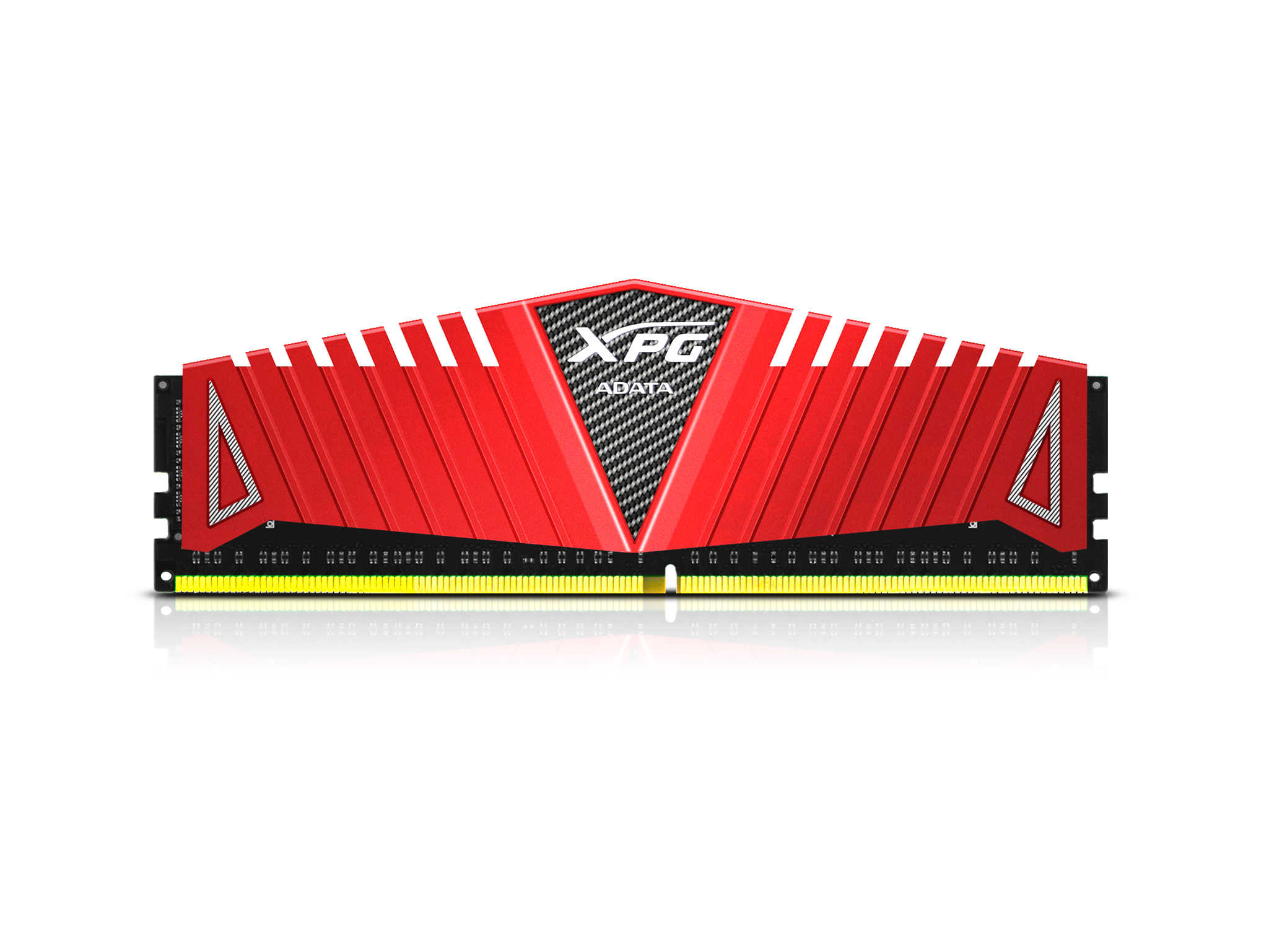Adata Also Announces Its DDR4 Overclocking Memory
This is Adata's new DDR4 overclocking memory.
Adata, after launching its premier DDR4 memory, has now announced its XPG Z1 DDR4 memory, which is the company’s overclocking memory. The memory modules are built to be used with the upcoming Haswell-E processors on the X99 platform.
Adata has built the DIMMs with 10-layer PCBs, along with 2oz copper. They also operate at just 1.2 V; DDR4 memory may run between 1.05 V through 1.2 V, which is lower than the 1.5 V through 1.65 V we saw for DDR3. This reduces power consumption, and thus heat output, making it possible to run at higher frequencies. On the units we find large red heatsinks, which will complement some builds, but not all. Hopefully the units will also be available in other colors in the future.
Regarding performance, the modules will be available with frequencies up to 2800 MHz. These modules will have CL17 timings. The cheapest units that will be available will run at 2133 MHz with CL15 timings. A step above that are 2133 MHz modules with CL13 timings, and there are 2400 MHz modules with CL16 timings, too. Each of these will be available in 4 GB or 8 GB DIMMs. Adata has made kits available with either two 4 GB modules, two 8GB modules, four 4 GB modules, or four 8 GB models, so kit capacities range from 8 GB through 32 GB.
Overall, it is clear that DDR4 memory is still young. We’ve seen faster DDR3 memory with lower timings, but that’s okay; as time goes on we’ll see better and better DDR4 memory come along -- when DDR3 came out it also wasn't much better than existing high-end DDR2, so we're not all that surprised. We expect that once DDR4 hits mainstream implementations the real jump will happen.
No word on pricing yet, though we do know that the units will be available soon, likely in time for the Haswell-E release mid-September.
Follow Niels Broekhuijsen @NBroekhuijsen. Follow us @tomshardware, on Facebook and on Google+.
Get Tom's Hardware's best news and in-depth reviews, straight to your inbox.
Niels Broekhuijsen is a Contributing Writer for Tom's Hardware US. He reviews cases, water cooling and pc builds.
-
heero yuy CL17? WHAT THE HELL?Reply
well DDR4 is getting off to a great start... higher bandwidth (but nothing faster than what can already be found in DDR3 and i doubt the prices will be much better) and crappy timings... (you could probably get ddr3 3000 with lower timings than this) -
InvalidError Reply
But not at 1.2V... or even 1.5V.13903056 said:(you could probably get ddr3 3000 with lower timings than this)
The chip-making process used to achieve high-density DRAMs is notoriously bad at high-speed stuff (making smaller DRAM cells requires a substrate with higher dielectric constant and lower leakage, which translates into FETs with higher gate capacitance and lower electron mobility, making them slower to switch) and with less voltage swing to help those transistors switch, latencies go up to give them more time to do so.
Higher bandwidth memory with somewhat worse latency is still win-win for IGPs. -
koolkei i really feel this is too early...... i mean it hasn't matured enough, and in a year, we'll probably see DDR4-3200 is the normal high end RAM and the overclocked version have MUCH higher freq..... this is just what i think thoReply -
Shneiky 2800 Mhz at 17 timings.... Still beaten up by 1600 Mhz 9 latencies in productivity software. Hope we can at least see 1866 with 9 timings or 2133 with 9 timings when this technology matures. (For the record, productivity software is much more sensible to latency, thats why I am so fixed on it).Reply -
boller So, if I got this right, it might be possible that 6c Ivy-E with good DDR3 sticks attached will beat the crap out of 6c Haswell-E... And for long enough time so that Broadwell-E will pop up before DDR4 is good enough... Interesting...Reply -
InvalidError Reply
Latency in terms of clock cycles is getting worse with every generation and the reason for that is that real latency in terms of actual time in ns is progressing much more slowly than data rates are: DDR1-400-3 is 15ns latency while 2133-10 is 9.4ns.13903677 said:(For the record, productivity software is much more sensible to latency, thats why I am so fixed on it).
Net DRAM latency has improved by about 33% over the past decade while bandwidth has quintupled. -
razor512 ReplyCL17? WHAT THE HELL?
well DDR4 is getting off to a great start... higher bandwidth (but nothing faster than what can already be found in DDR3 and i doubt the prices will be much better) and crappy timings... (you could probably get ddr3 3000 with lower timings than this)
The timings are high so that if the laws of physics were to ever change, you will have time to manipulate the electrons by hand in between RAM operations. :) -
falchard When you increase bandwidth you increase timing, its been true throughout all memory improvements. Wait for DDR4-3200 as a minimum.Reply -
Shneiky @InvalidErrorReply
The article gives 2133 MHz with CL15 timings. The 2133 with 10 timings that you use to produce 9.4 nanoseconds will be in this case 14.1 for the 2133 with 15 timings. While my good old 1333 at 9 sits at 13.5 and the 1600 at 9 sits at 11.2. In this case, even one of the pricy 1333-7 does better with 10.5. And a 1333-7 has almoust 40% less latency than the 2133-15. As I said, I hope the technology matures. I was super hyped about DDR4 (I am waiting for DDR4 in the mainstream socket to upgrade my 2700K, well maybe ... if it is worth it). But apparently for now the only benefits are higher density and lower voltage. (Which in a typical desktop does not matter. the power reduction is close to small single digit watts). Hope that DDR4 matures by the time Skylake hits and we can get some descently priced 2133-9 kits of 2x8 or so.

